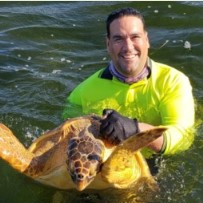Sea Turtles: Ecology, Distribution, and Conservation
A special issue of Animals (ISSN 2076-2615). This special issue belongs to the section "Herpetology".
Deadline for manuscript submissions: closed (17 February 2023) | Viewed by 40818
Special Issue Editors
Interests: coastal ecology; conservation biology; endangered species management; geographic information systems (GIS); spatial analysis
Interests: spatial ecology; foraging ecology; GIS for conservation; marine megafauna; community-based conservation
Special Issue Information
Dear Colleagues,
Sea turtles are charismatic megafauna whose conservation represents a complex web of biological, environmental, economic, and human-related interactions. Their life history utilizing both sensitive terrestrial and marine environments makes them difficult to study, while their diverse ecological, cultural, and economic value makes their conservation critical. The threats sea turtles face from climate change, sea level rise, habitat loss, coastal development, bycatch, and others are a microcosm for coastal conservation issues the world over. In this Special Issue, we seek diverse perspectives and innovative techniques used to assess and promote sea turtle ecology, distribution, and conservation from local to global scales. Manuscripts detailing in-water animal behavior (e.g., feeding ecology, intra- and interspecies interactions, threat avoidance, diving patterns, animal-borne cameras or biologging devices), nesting processes (e.g., spatiotemporal patterns, hatchling production and clutch loss), marine habitat use (e.g., drone surveys, satellite and acoustic telemetry, long-term capture–mark–recapture studies), and conservation management and use decisions (e.g., nest relocation, hatcheries, bycatch reduction, fishery interactions, Indigenous and commercial harvest, marine protected area planning, environmental and population modeling) are welcome. Submissions from regions currently underrepresented in the broader literature and local-level conservation interventions are particularly encouraged.
Dr. Matthew Ware
Dr. Natalie E. Wildermann
Dr. Héctor Barrios-Garrido
Guest Editors
Manuscript Submission Information
Manuscripts should be submitted online at www.mdpi.com by registering and logging in to this website. Once you are registered, click here to go to the submission form. Manuscripts can be submitted until the deadline. All submissions that pass pre-check are peer-reviewed. Accepted papers will be published continuously in the journal (as soon as accepted) and will be listed together on the special issue website. Research articles, review articles as well as short communications are invited. For planned papers, a title and short abstract (about 100 words) can be sent to the Editorial Office for announcement on this website.
Submitted manuscripts should not have been published previously, nor be under consideration for publication elsewhere (except conference proceedings papers). All manuscripts are thoroughly refereed through a single-blind peer-review process. A guide for authors and other relevant information for submission of manuscripts is available on the Instructions for Authors page. Animals is an international peer-reviewed open access semimonthly journal published by MDPI.
Please visit the Instructions for Authors page before submitting a manuscript. The Article Processing Charge (APC) for publication in this open access journal is 2400 CHF (Swiss Francs). Submitted papers should be well formatted and use good English. Authors may use MDPI's English editing service prior to publication or during author revisions.
Keywords
- marine turtle
- habitat use
- coastal zone management
- impact assessment
- environmental modeling
- conservation management and practice
- nesting ecology
- trophic interactions
- telemetry and biologging








